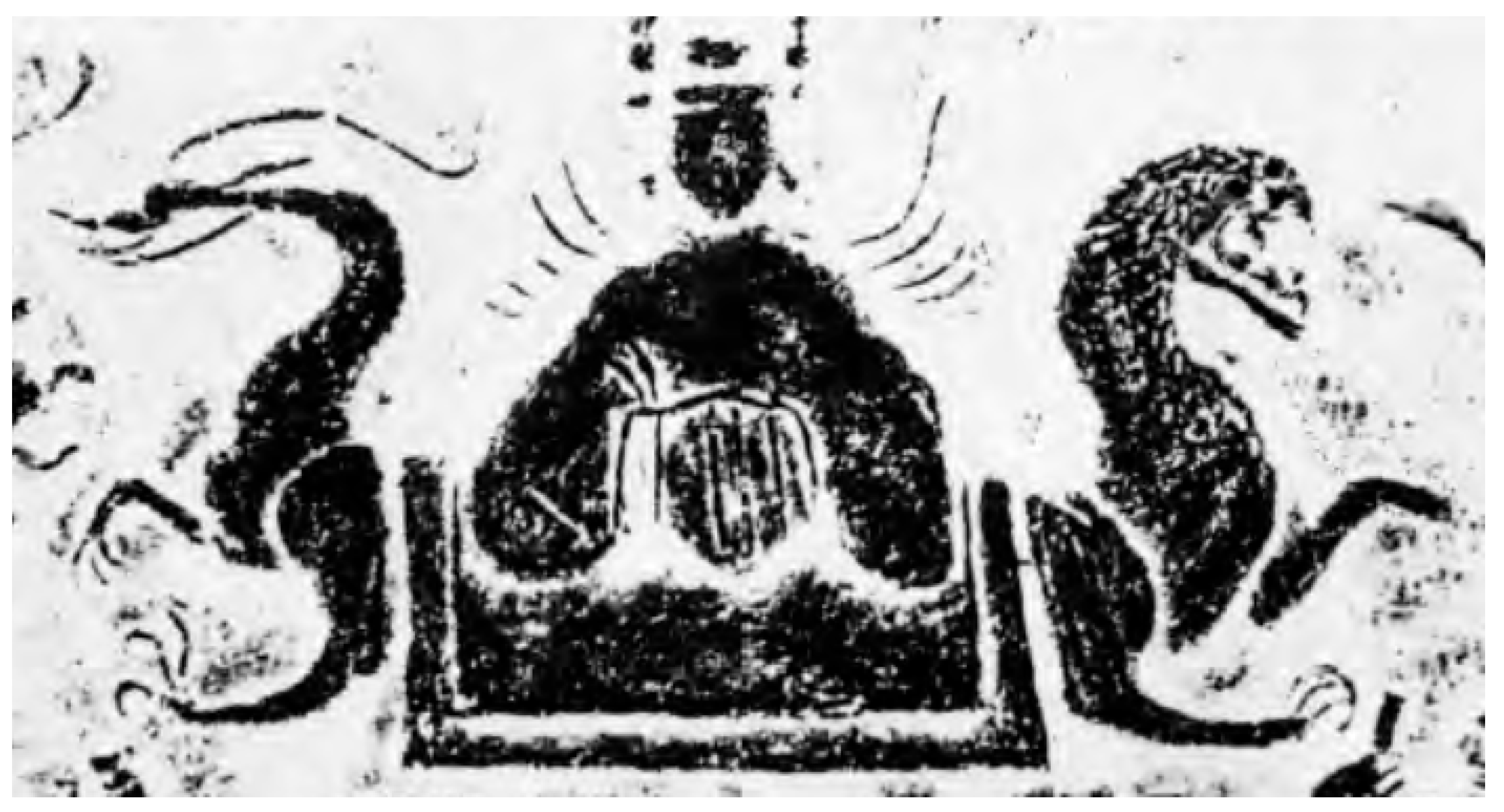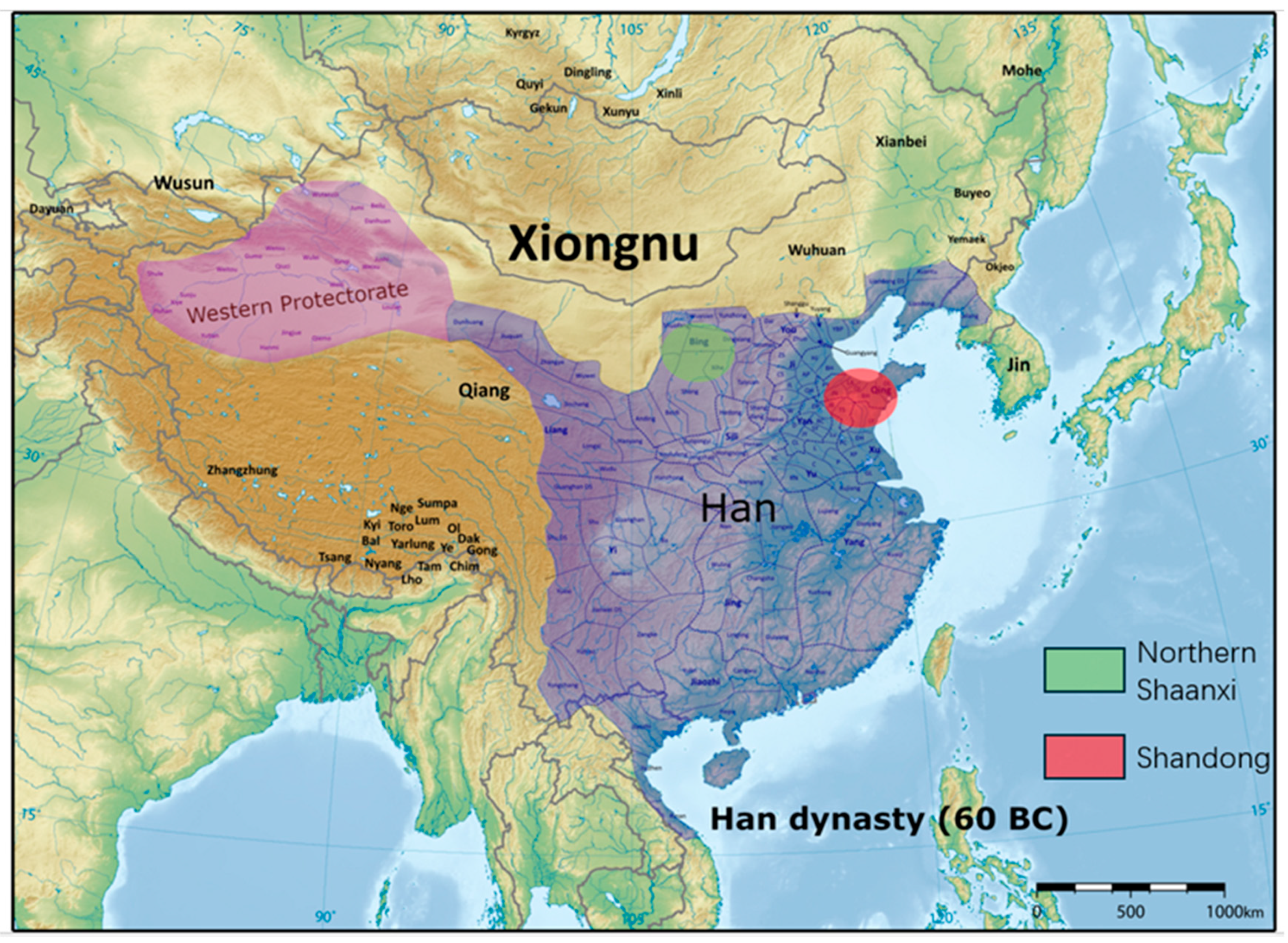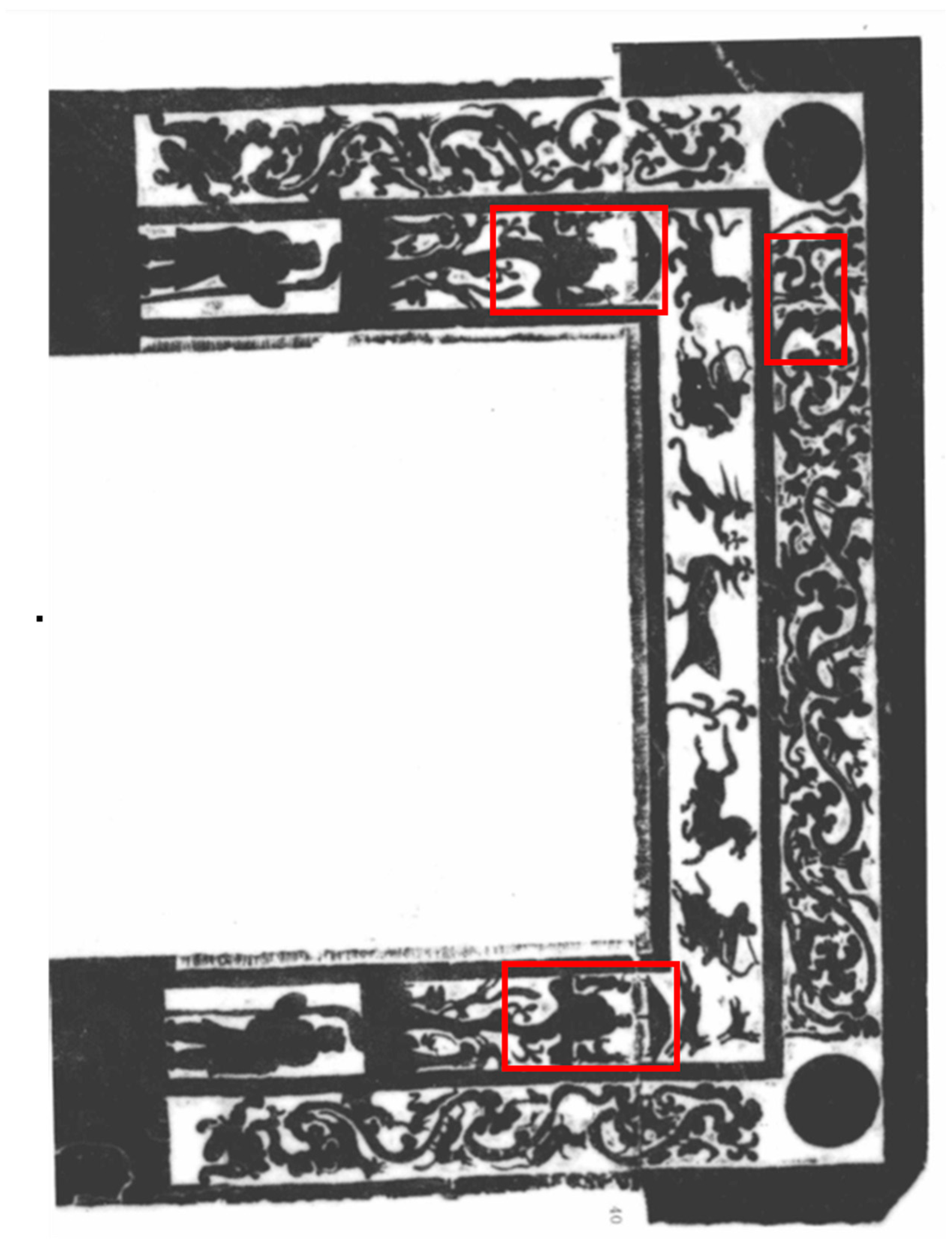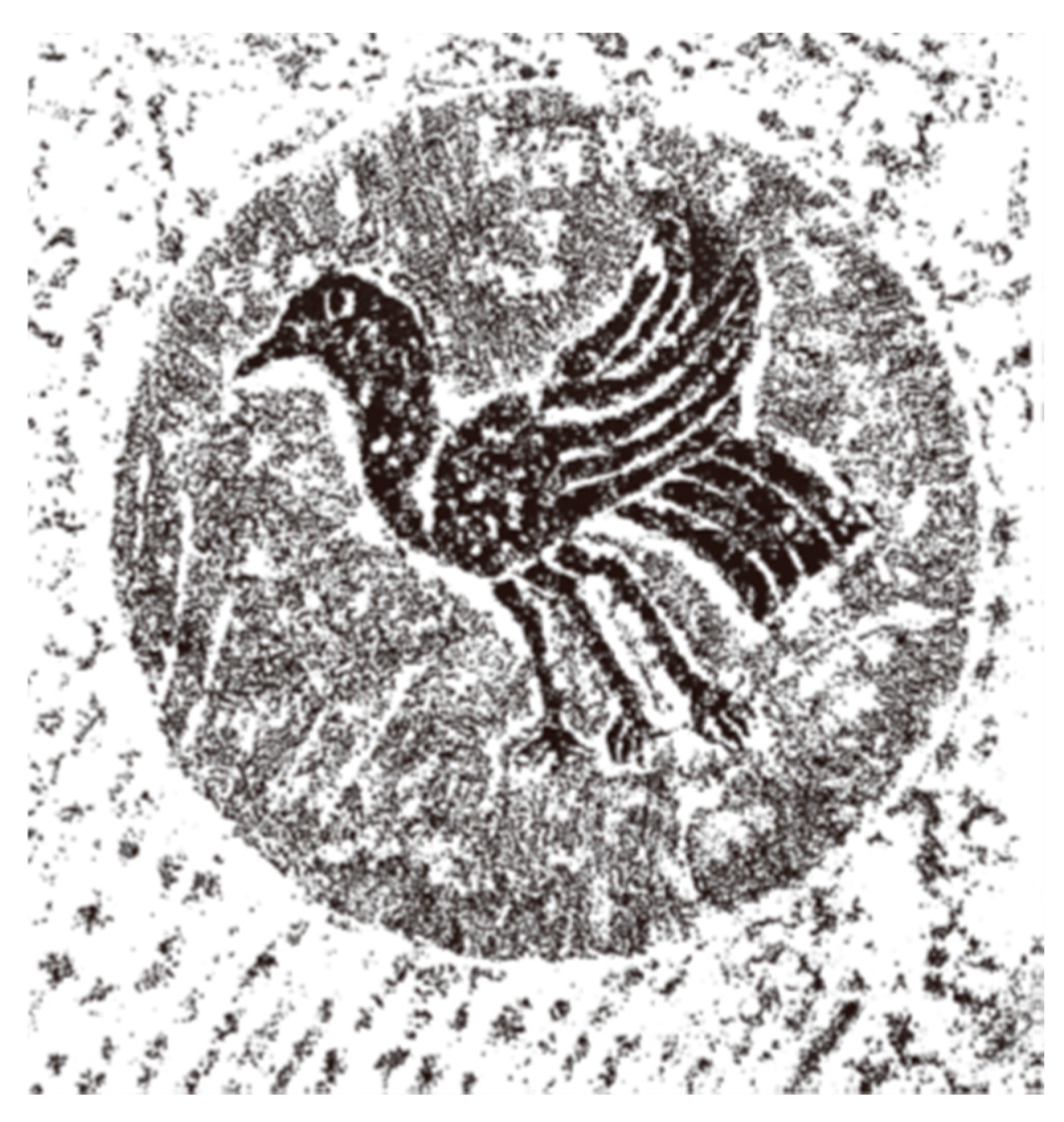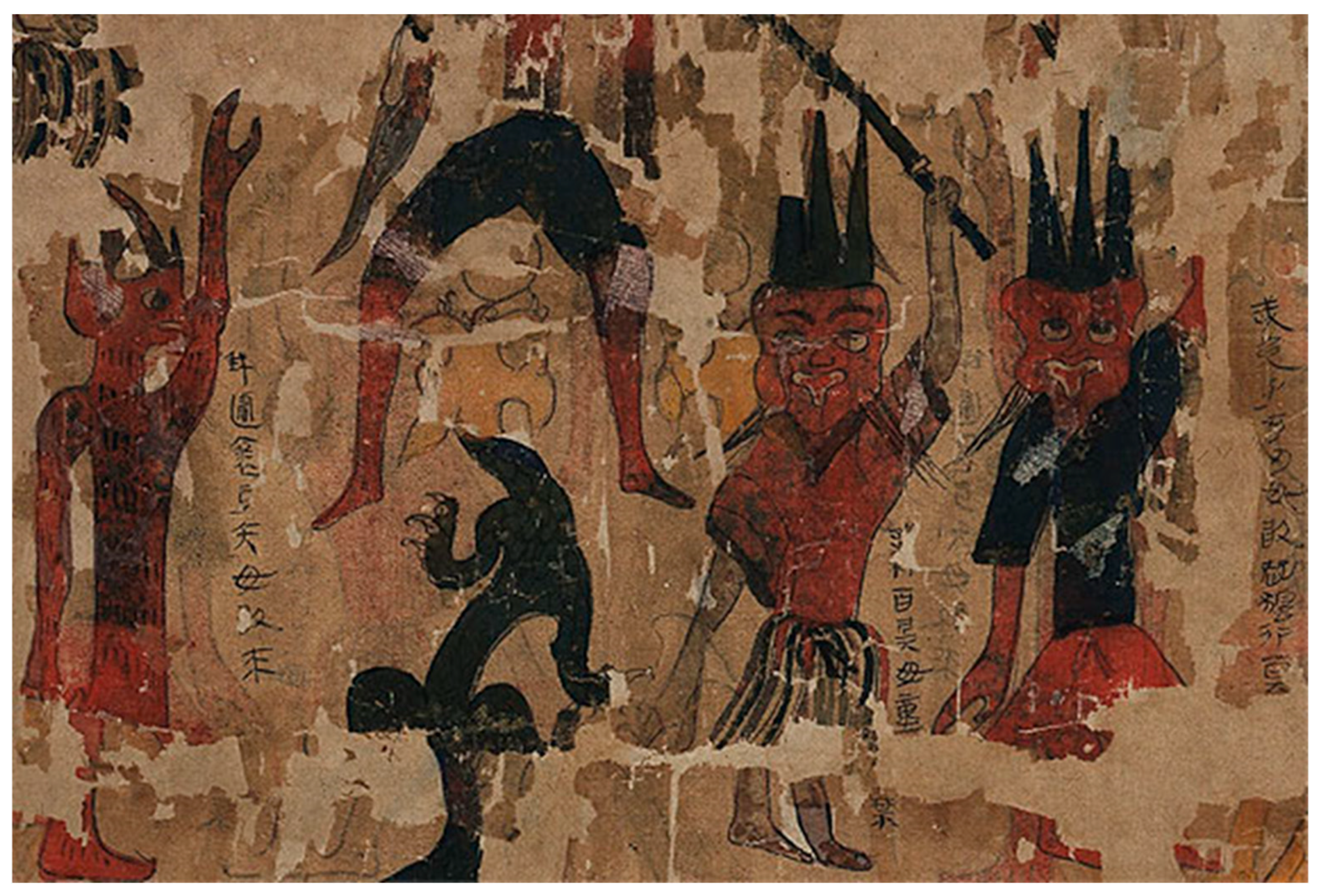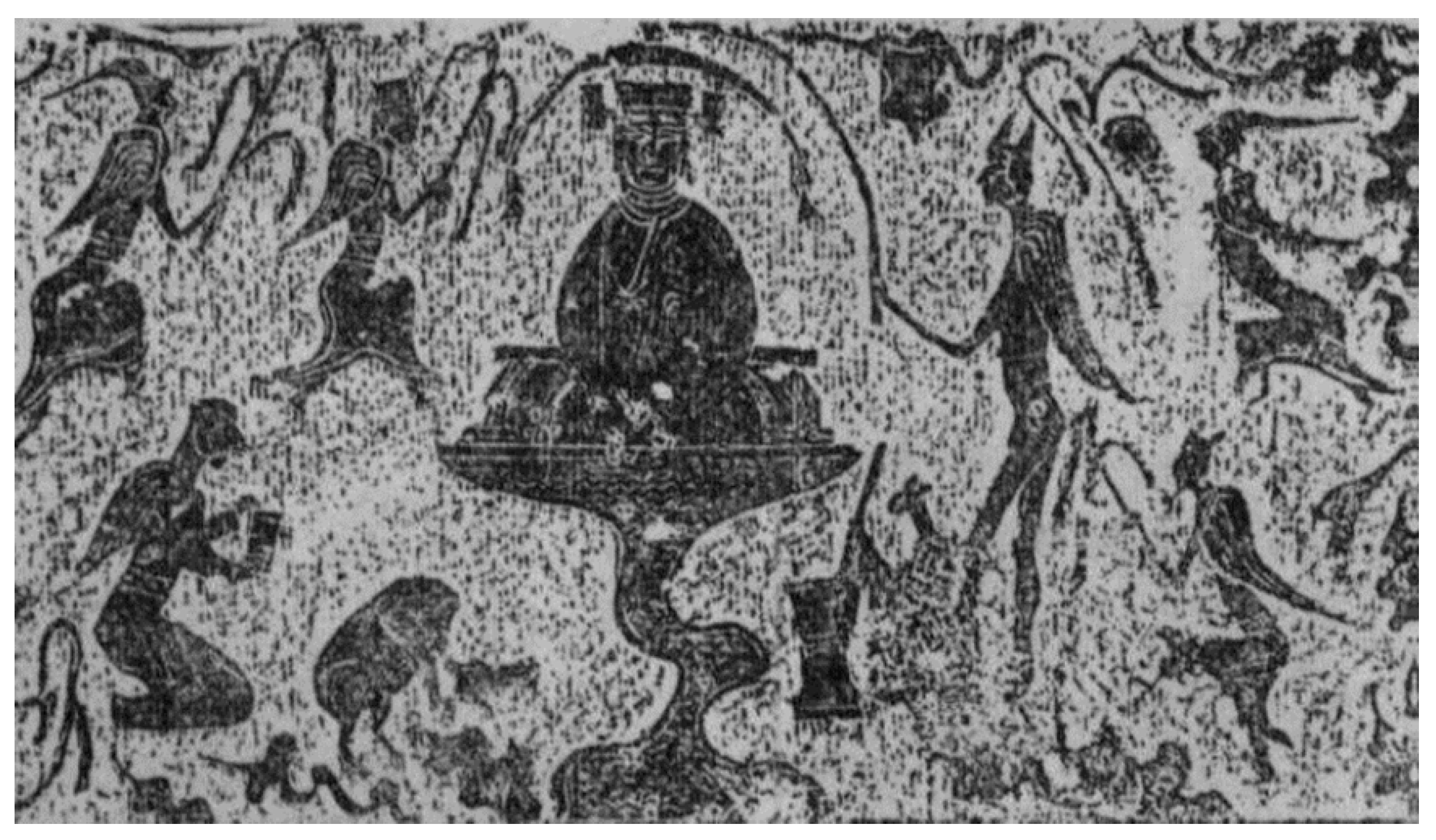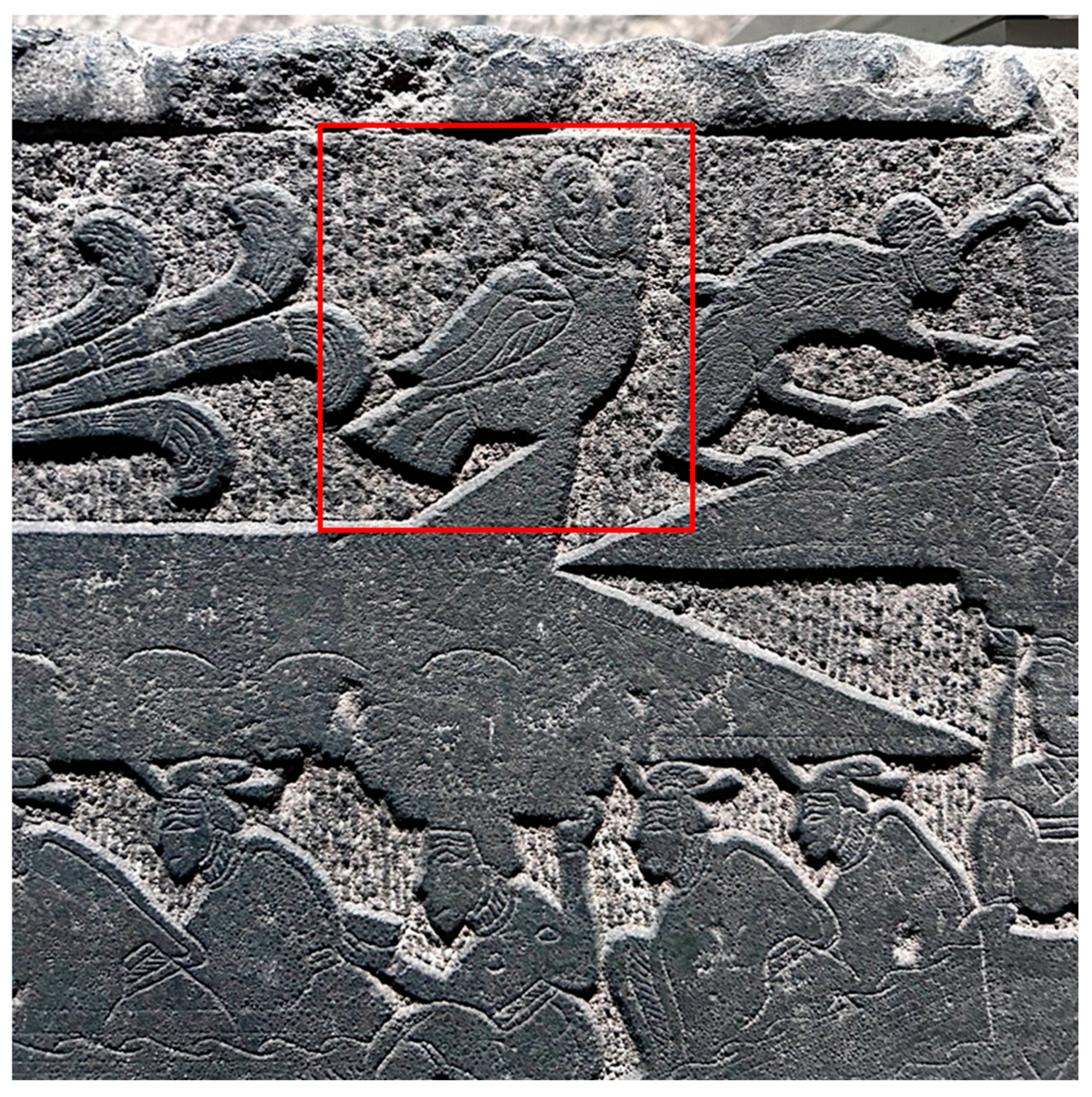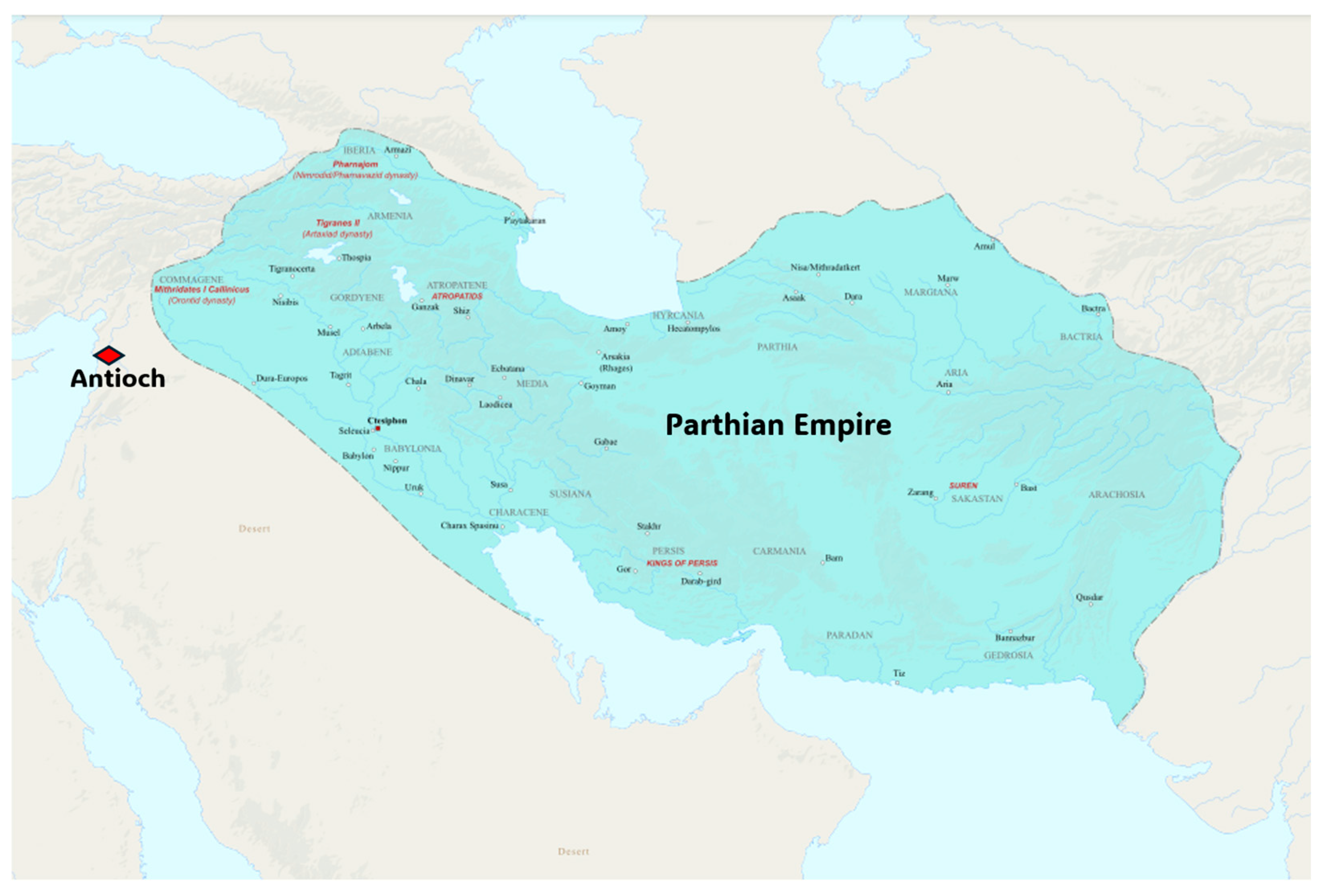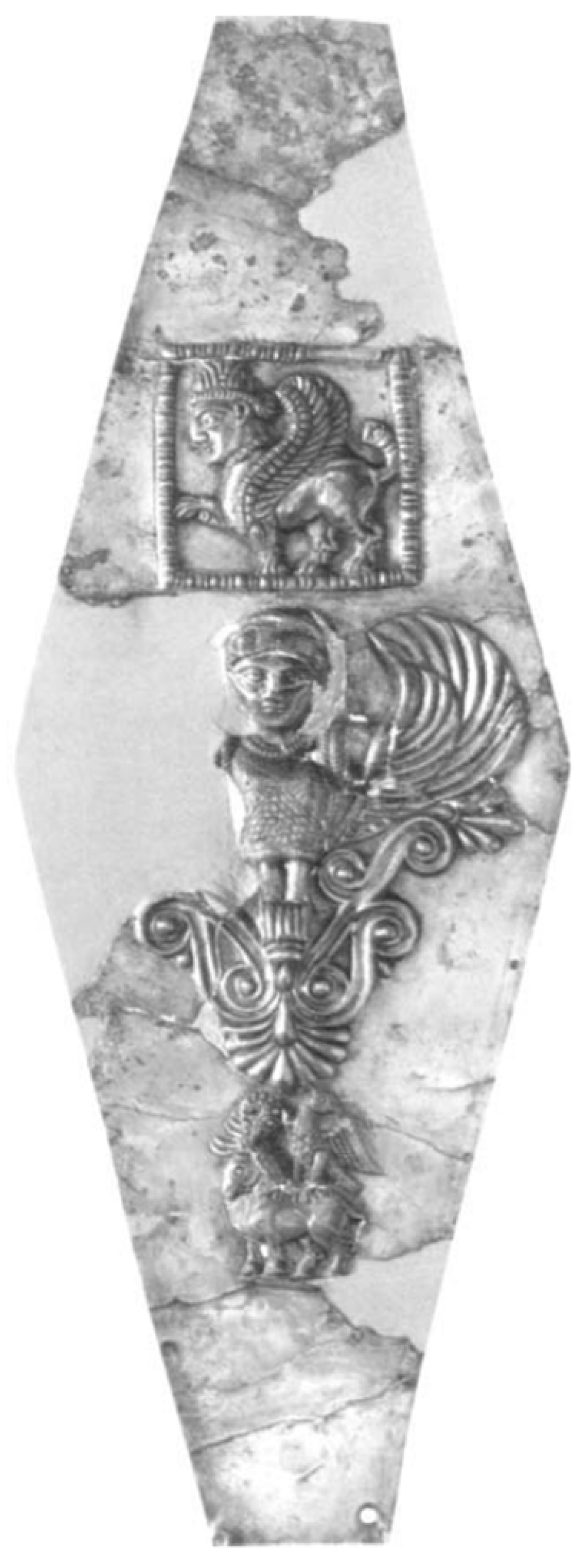1. Introduction
The Queen Mother of the West (Xiwangmu), a prominent deity in ancient Chinese mythology, holds a significant presence in funeral art during the Western and Eastern Han Dynasties (ca. 202 BCE–220 CE) (
S. Li 2000, pp. 1–6). Archaeological discoveries have unearthed a plethora of depictions of this goddess, making her a prevailing motif across various media, especially on pictorial stones.
Pictorial stone (huaxiangshi) is an archaeological term commonly used by Chinese archaeologists and sinologists to refer to architectural stones adorned with carved patterns on structures such as underground chambers, tomb gates, and cemetery shrines during the Han dynasty, when pictorial stone was one of the most commonly used materials for constructing burials.
In the past, several scholars from both the West and the East—such as Michael
Loewe (
1994),
James (
1995),
S. Li (
2000) and
H. Wu (
1989)—have researched images of the Queen Mother of the West depicted on Han pictorial stones. Their collective studies have shed light on her portrayal, typically as a seated woman shown in profile or frontal view on pictorial stones (
Figure 1), often accompanied by numerous mythical creatures, such as the winged horse, feathered man, dragon and tiger. Over time, research and discourse on this goddess have expanded (
Carter 2006;
Tseng 2011;
Wang and Tang 2015). However, one particular motif sometimes shown alongside her on pictorial stones—the
human-headed bird—remains relatively underexplored, owing to its small scale and peripheral placement in the composition.
During the Han dynasty, depictions of human-headed birds appeared at several sites, mainly concentrated in two regions of China: northern Shaanxi and Shandong (as shown in
Figure 2). These images represent a compelling subject of study, yet their meaning and their connection to the revered deity, the Queen Mother of the West, require further investigation.
This paper systematically compares the portrayals of human-headed birds on Han pictorial stones from Shaanxi and Shandong to illustrate how visual culture can serve as an analytical medium for exploring early transcultural interactions between China, the Silk Road, and broader regional civilisations. It first presents the main occurrences of the human-headed bird motif in the iconographic context of the Queen Mother of the West. It then undertakes a detailed iconographic analysis of the motif in dialogue with both visual and textual sources, aiming to identify it with the mythological Blue Bird and to distinguish it from similar or previously conflated figures. Finally, by applying the theoretical framework of the chaîne opératoire, the study examines the processes through which this hybrid iconography emerged and evolved, shedding light on the interplay between artistic innovation and cultural exchange in Han funerary art.
2. Human-Headed Birds with the Goddess
A common practice in depicting the Queen Mother of the West is to present her alongside related motifs in a symmetrical composition on the pictorial stones of tomb gates. This can be seen in a notable group of eleven pieces featuring similar compositional imagery, all bearing human-headed birds. These stones are mainly dated to the Eastern Han dynasty (25–220 CE) and are concentrated in Mizhi and Suide, in northern Shaanxi Province (
Li et al. 1995, p. 11). Using the pictorial stones from Hejiagou, Suide, as an example, the composition of the scene can be divided into three distinct parts: the upper portion, the left side, and the right side (
Figure 3).
The left and right sides of this pictorial stone exhibit a high degree of symmetry, each featuring a deity (positioned beneath canopies) in a distinct representational format. Scholars such as James have identified this composition as a conventional depiction of the Queen Mother of the West and the King of the East (Dongwanggong), based on comparable pictorial stones discovered in northern Shaanxi. These deities are placed on either side of the tomb doorway, each standing on a pedestal shaped like a tree. Regarding the two black circular motifs at the top, they were originally intended to represent the sun and the moon positioned above the two deities (
James 1995, pp. 23–24). The inclusion of these celestial elements reinforces the symbolic significance of the scene. The outer rim surrounding the sun and moon is decorated with curling cloud motifs, interwoven with grass patterns and various animals.
On the upper left side of the composition, a human-headed bird can be seen. In this portrayal, a feathered man raises his right arm while holding a vessel (
Figure 4). The composite creature stands on a curly plant in profile, with its face turned towards the viewer. Its face is round, with linear eyebrows and eyes, vermilion-painted lips, and short legs. Its body is outlined in ink, featuring red dots on the feathers and curly lines on its chest. The overall depiction is composed of simple lines. Its wings are tightly closed, and its tail is slightly short and arched. Two curved lines on the chest suggest the curvature of the body, while parallel, neatly arranged lines depict the feathers of the wings and tail section. The overall figure is highly rounded, resembling a bird in form, with only the face carved with human features.
In Shandong, another region where human-headed birds appear in concentration, the composition and artistic expression of these images differ notably from those found in northern Shaanxi. One illustrative example is a pictorial stone tomb excavated in Jiaxiang, Shandong Province, dated to the 2nd century CE (
Zhu 1979, p. 6). Three carved pictorial stones from this tomb depict human-headed birds. The composition of these stones follows a consistent structure: horizontal lines divide the surface into several registers arranged from bottom to top. The lower registers typically feature scenes from daily life and historical anecdotes, while the uppermost register is reserved for mythological imagery.
For instance, in
Figure 5, the bottom register of the pictorial stone shows a procession of chariots and horse-drawn carriages; the third register depicts kitchen scenes and food preparation; the second register features an instrument performance and dancing figures. In the top register, the Queen Mother of the West appears centrally, shown in her most common form—a frontal seated pose. On either side of her are several feathered figures, and to the far left stands a human-headed bird. It faces right, with one leg stepping forward in a walking stance. Both arms are raised, holding a column-like object. Its tail and wings stretch backward into angular, triangular shapes.
In the past, little scholarly attention has been paid to the human-headed bird imagery from northern Shaanxi. By contrast, the human-headed birds from Shandong have occasionally attracted scholarly interpretations. Most scholars have identified these figures as depictions of the divine physician Bian Que (ca. 407–310 BCE)—for example, Liu Dunyuan in the 1970s and more recently Wu Qiupeng (
Liu 1972, pp. 47–51;
Q. Wu 2021, pp. 4–10). Bian Que was a renowned medical practitioner of the Warring States period (ca. 475–221 BCE) in ancient China. Historical texts record his exceptional medical skills, and some aspects of his life and practice are described in mythologised terms (
Salguero 2009, p. 184). The primary basis for identifying the human-headed bird as Bian Que lies in its depiction holding a stick-like object (as seen in
Figure 5), which scholars have interpreted as a representation of the physician performing acupuncture with a needle (
Liu 1972, p. 47;
Q. Wu 2021, p. 4).
Building upon previous research and taking into account the concurrent depiction of the goddess Queen Mother of the West—well-attested in Han dynasty myths and literary sources—this paper proposes a new interpretation of the human-headed bird motif, the Blue Bird (Qingniao).
3. Concordance Between Textual Content and Visual Elements
The Classic of Mountains and Seas (Shanhaijing), an ancient Chinese text detailing geography and mythical creatures, includes a detailed description of the Queen Mother of the West: “She leans against a table and wears a headdress. To the south, there are three Blue Birds that gather food for her (xiwangmu tiji er daisheng, qinan you sanqingniao, wei xiwangmu qushi 西王母梯幾而戴勝杖, 其南有三青鳥, 為西王母取食)” (
Yuan and Zhang 1980, p. 306). These birds are further described as having “red heads and black eyes (chishou heimu 赤首黑目)” (
Yuan and Zhang 1980, p. 399).
This portrayal of the Blue Bird is reaffirmed in
Bowuzhi (meaning Records of Diverse Matters), written by Zhang Hua in the third century CE, where it is described as “standing beside the Queen Mother of the West and serving her, appearing similar in size to ravens (yousanqingniao, ruwuda, lishi mu pang 有三青鳥, 如烏大, 立侍母旁)” (
H. Zhang 1990, p. 31). Guo Pu (276–324 CE), shortly after the Eastern Han Dynasty, provides additional insights in his commentaries on a mountain from the Classic of Mountains and Seas, emphasising that “the three Blue Birds are specifically tasked with fetching food for the Queen Mother of the West (sanqingniao zhuwei xiwangmu qushi zheye, biezi qixiyu cishanye 三青鳥主為西王母取食者, 別自棲息於此山也)” (
Yuan and Zhang 1980, p. 54).
From these historical records, we can deduce some key characteristics of the Blue Birds: firstly, they are mythical creatures within the realm of the Queen Mother of the West, and secondly, their primary duty revolves around serving and providing sustenance for her. Due to the scarcity of specialised studies, some scholars have occasionally associated the Blue Bird with another bird that accompanies the Queen Mother of the West, known as the Three-footed Raven (Sanzuwu). Li Song, for instance, once suggested that Three-footed Birds possess dual identities: the Blue Bird and the Golden Bird (Jinwu, a different name for the Three-footed Raven) found in the sun (
S. Li 2000, p. 256). To arrive at this conclusion, he combined historical records and visual arts from burial contexts. However, a gap exists between these two sources of information. Contrary to the Blue Bird, the Three-footed Raven is consistently associated with the sun in historical documents, such as the
Lun Heng (written in the Eastern Han Dynasty by Wang Chong) that states “there is a Three-footed Raven in the sun (rizhong you sanwu 日中有三足烏)” (
C. Wang 1990, p. 502).
Furthermore, the
History of the Eastern Han (Houhanshu, written in the 4th-5th century CE) records that “the sun is the father of the yang energy of heaven and earth, and when this yang energy accumulates, it becomes a divine bird in the form of a raven, which has three legs (rizhe, yangjing zhi zong, jier chengniao, xiangwu er you sanzhi 日者, 陽精之宗, 積而成鳥, 象烏而有三趾)” (
Fan and Li 1971, p. 3216). From the perspective of visual art, the Three-footed Raven is also consistently depicted with solar-related attributes (
Figure 6), further highlighting its unique identity. Notably, in the pictorial stones of Shandong and Northern Shaanxi, where human-headed birds appear, Three-Footed Ravens are also present (
Figure 7), always identifiable by their defining characteristic—the three feet. In summary, the Three-Footed Raven is consistently shown with three feet and often linked to the sun. However, neither of these traits is found in descriptions of the Blue Bird, making it clear that the two should not be mistaken as dual representations of the same entity.
While both are mythical creatures in the realm of the Queen Mother of the West, and the Three-Footed Raven appears on these pictorial stones, this raises the possibility that representations of the Blue Bird may also be present in these scenes. Historical records indicate that the Blue Bird had a specific role in serving and providing food for the Queen Mother of the West in her mythical domain. Examining the depiction of human-bird hybrid figures reveals that this duty is embedded in the imagery the artisans sought to convey, along with several key elements linking the human-headed bird to the Blue Bird.
Standing in profile with its face directed towards the viewer, the human-headed bird figure showcases three distinctive features deserving particular attention (as seen in
Figure 4). Firstly, a man positioned on the lower left raises a food-shaped vessel towards the bird. The person’s dynamic posture suggests the active presentation of the food, while the bird stands statically, receiving the offering. The spatial relationship between the two indicates the bird’s elevated status, making it more likely to receive the presented food. Curiously, the scene does not portray the bird engaged in eating, leading one to speculate that it may serve as a food carrier, the responsibility of the Blue Bird in historical myths.
Secondly, sources mention that this bird possesses a red head (see content related to Classic of Mountains and Seas in the previous text). Although many pictorial stones have lost their original colours, there is an exceptional case where traces of colour remain. In March 2003, Mr. Li Lin donated three Han dynasty pictorial stones to the Xi’an Beilin Museum. These stones were unearthed from a Han tomb in Hejiagou, Suide, Shaanxi Province, in January 2001. Zhao Liguang, a curator at the museum, observed a red lip and red spots on the bird’s feathers in one of the pictorial stones (
Zhao 2005, p. 56). Based on this evidence, identifying the human-headed bird figure as the Blue Bird becomes more convincing.
Thirdly, the human-headed bird in
Figure 4 wears a distinctive crown known as the three-mountain crown (Sanshanguan), named for its mountain-like shape and longstanding tradition. This unique form was commonly used to signify deities in Chinese artwork (
Sun 2006, pp. 52–53).
Li Song (
2009, pp. 67–74) observed that some depictions of the King of the East on Han dynasty pictorial stones in northern Shaanxi also feature this type of crown. Beyond pictorial stones, a similar three-mountain-shaped crown can be seen on a silk painting from the Western Han dynasty (
Figure 8), adorning deities (
S. Li 2009, p. 44). The identical shape of this crown, with its three triangular peaks, is clearly discernible on the human-headed bird in the pictorial stone. This evidence supports the conclusion that the human-headed bird figure is not a representation of a real-world bird but rather a significant and divine creature in the mythical realm of the Queen Mother of the West—the Blue Bird—as determined through a process of elimination.
4. A Specific Variation and a Mythical Plant
Based on the identification of the human-headed birds in northern Shaanxi (
Figure 5) as representations of the Blue Bird, this conclusion can more easily be applied to the human-headed bird depicted alongside the goddess in Shandong (
Figure 6). However, there are some notable differences in the Shandong case, particularly in the bird’s more complex gesture. It holds a stick-like object in its hand, which has been a key factor in previous interpretations. Given the presence of the Queen Mother of the West in these compositions and the previous argument regarding the Blue Bird, two key counterarguments challenge the identification of these human-headed figures as Doctor Bian Que performing acupuncture. Instead, they may represent another variation of the Blue Bird.
Firstly, as the highest-ranking deity in the divine hierarchy during the Han dynasty, the Queen Mother of the West would have no need for acupuncture. According to Han dynasty beliefs, she was regarded as eternal, as ancient as the heavens themselves. A Han text,
Yilin, states that her age is unknown and that she “exists in harmony with the heavens (sheng buzhilao, yu tian xiangbao 生不知老,與天相保)” (
S. Li 2000, p. 32). While Dr. Bian Que was a highly skilled and renowned physician, he was still a mortal and lacked the divine status necessary to heal such a revered goddess. Furthermore, the composition of the imagery suggests an offering scene: the figures flanking the Queen Mother of the West are all oriented towards her, leaning slightly forward in a gesture of reverence. Clearly, an acupuncture needle would not be an appropriate offering for a deity of her stature. Additionally, even the feathered man positioned in front of the human-headed bird is holding a similar object, further challenging the interpretation of the item as a medical tool.
Secondly, a closer examination of other Han visual art can provide insights into the exact nature of the object held by these human-bird figures. A pictorial stone excavated from the same region, Shandong (
Figure 9), depicts the Queen Mother of the West seated frontally at the top right of a tomb gate. To her left and right stand a few attendants, each holding a columnar object resembling an ear of wheat, evidently presented as an offering to her. The offerings presented to the Queen Mother of the West by her attendants are particularly noteworthy. The shape and intricate details of the objects they hold strongly and unambiguously convey the artisan’s intent—they are ears of wheat. Revisiting
Figure 5, one can observe that the objects held by the human-headed bird and the feathered man share a similar length and form, with a slight curvature closely resembling the natural appearance of wheat. Additionally, their slightly protruding tips subtly suggest the presence of grains, even though the details are not fully rendered.
In fact, these grains are not ordinary plants, as it is clear that the goddess would not require common crops. During the Han Dynasty, a special type of wheat known as Jiahe flourished. The name itself means “good cereals with many spikes”, and in the beliefs of the time, Jiahe was of great significance. It symbolised good weather and a bountiful harvest, ranking among the five auspicious symbols (
Zhou and Liu 2006, pp. 325–69). It was celebrated as a representation of prosperity and favourable agricultural conditions. The
Baihutong, a text from the Eastern Han Dynasty which mainly focuses on social systems, cultural concepts and myths and legends, records: “Good grain grows when character saturates the land (dezhidi, ze jiahe sheng 德至地, 則嘉禾生)” (
L. Chen 2018, p. 283), emphasising the close connection between virtuous conduct and the flourishing of this auspicious crop.
Fortunately, a stone tablet carved in 171 CE during the Eastern Han Dynasty (
Figure 10) provides insight into five of the most widely recognised auspicious symbols of the time, each inscribed with its name beside its corresponding depiction. (As the original stele is blurred, a Qing-dynasty copy from the Jin Shi Suo is provided here; the overall composition and imagery remain the same.) In the scene, Huanglong (Yellow Dragon) is positioned at the top left, Bailu (White Deer) at the top right, Mulianli (Two Intertwined Trees) at the bottom left, and Ganlujiang (Nectar Drops from the Tree) at the bottom right. At the centre-bottom, a plant is depicted as a sapling with nine spikes and several short, thin branches and leaves along the main culm. The spikes droop elegantly and symmetrically, creating a visually striking composition. An adjacent inscription reads “Jiahe”, confirming its identity as the auspicious grain.
Moreover, another Eastern Han pictorial stone from the same region (
Figure 11) reveals a compelling scene depicting the offering of Jiahe to the Queen Mother of the West, similar to the compositions in
Figure 5 and
Figure 10. In this portrayal, the divine goddess is seated at the centre, flanked on both sides by attendants gracefully presenting Jiahe as an offering (
X. He 2012, pp. 11–19). This scene confirms that the motif of the “Goddess Receiving Jiahe” was not an isolated instance on Han dynasty pictorial stones. Rather, it appears to be a fixed iconographic theme that combines two divine elements, the goddess and the auspicious plant, and underscores the symbolic significance of Jiahe within the mythological context.
Various myths from that era attribute magical properties to Jiahe, elevating it beyond the status of an ordinary grain. According to one account in the 4th century CE, “a vermilion bird (Zhuque, a divine bird in Chinese mythology) carried nine ears of grain (Jiahe); some fell to the ground, and the emperor, upon finding one of the fallen grains, consumed it and then planted it in the fields, believing that anyone who consumed this special grain would attain eternal life (shiyou danque xian jiusuihe, qi zhuidizhe, di nai shizhi, yi zhiyutian, shizhe laoerbusi 時有丹雀銜九穗禾,其墜地者,帝乃拾之,以植於田,食者老而不死)” (
J. Wang 1989, p. 5). Such narratives enhanced the mystical significance of Jiahe in the cultural imagination of the time and explained why it could be offered to the Queen Mother of the West, as it symbolises not only prosperity but also immortality.
In summary, through a meticulous comparison of the composition of the “Offering to the Queen Mother of the West” scenes and those featuring human-headed birds in Shandong, alongside relevant historical records, strong indications emerge that the human-headed birds depicted with the Queen Mother of the West in Shandong are the same figures as those in northern Shaanxi, namely, the Blue Bird. Moreover, although the figure represents the Blue Bird, artisans in Shandong developed a more innovative theme by incorporating another mythical motif, Jiahe. This gave rise to a local variation: “Offering Jiahe to the Queen Mother of the West”. In this context, Jiahe, an auspicious plant that symbolises immortality in Han dynasty mythology, further enhances the divinity of the Queen Mother of the West. In both regions, the role of the Blue Bird in fetching food for the goddess is indicated through the composition and arrangement of image elements.
5. Chaîne Pératoire Analysis of the Ideological Origin and Myths Diffusion
Based on the foregoing analysis, although the artisans differed in their selection of narrative episodes—such as depicting the Blue Bird in the act of searching for food or presenting it to the Queen Mother of the West—a consistent representational feature remains: the fusion of a human face with a bird’s body. As this practice of inventing a composite creature is highly distinctive, closer attention should be paid to the integration of a human face into a bird motif. Moreover, the use of similar approaches in two different regions suggests that this may not have been an accidental innovation.
To further unravel the semiotic meanings and the generating mechanism underpinning this artistic choice, a deeper investigation into the social context of the Han Dynasty is imperative. The concept of “chaîne opératoire,” originally developed for lithic research to describe the mental operations and cultural transformations that raw materials undergo to fulfil specific needs (
Sellet 1993, pp. 106–12), has recently been applied in additional fields, including art, society, and human practices (
Farbstein 2011;
Porqueddu et al. 2023). In chaîne opératoire studies, the operational sequence is a central concern. When transposed to the field of visual representation, this concept can illuminate how an image takes form through a series of creative decisions—from conception and selection of iconographic elements to their combination and final execution. In the context of Han art, the chaîne opératoire thus serves as an analytical tool for tracing the cognitive and cultural processes underlying image-making of the human-headed bird.
The craftsmanship involved in producing Han pictorial stones was a specialised skill not possessed by all; patrons had to rely on skilled artisans to realise their requirements (
G. Chen 2005, p. 272). This dynamic between patrons and craftsmen underscores the symbolic importance of these artworks and the specific intentions behind their creation. Moreover, the simultaneous production of many such images suggests that a shared mode of thought was deeply rooted in society. By applying the chaîne opératoire approach, this study demonstrates how Han artisans integrated conception and raw materials (both internal and external sources) into a unified visual form, reflecting both artistic innovation and transcultural exchange.
As a creature that does not exist in nature, the uniqueness of the human-headed bird lies in its bizarre appearance. From prehistoric China through the Han Dynasty, a persistent social concept has been maintained in which deities are consistently endowed with unusual, often hybrid, features that blend human and animal traits (
S. Li 2000, pp. 275–78). This portrayal of deities in a supernatural gesture, as distinctly different from ordinary humans, is well attested in texts such as the
Classic of Mountains and Seas. A prevalent method to achieve such differentiation is to attribute a human–animal amalgamation to these divine figures. For instance, the god Zhurong, who was believed to govern fire, is depicted with a beastly body and a human head (
Guo 1877, p. 11). As the
Classic of Mountains and Seas states, “the gods are different in appearance from what people see (shenling suo sheng, qiwu yixing 神靈所生,其物異形)” (
Guo and Yang 1965, p. 113), reflecting a fundamental understanding of divinity during the Han Dynasty.
In contrast to the Three-Footed Raven, which already carries its own distinctive iconography (unlike the two-legged birds in nature), the Blue Bird does not possess inherent supernatural characteristics in the allusive accounts. However, as the esteemed attendant of the Queen Mother of the West, it is reasonable for the artisan to depart from the typical avian representation. Consequently, driven by this conception, artisans adopted the practice of bestowing a human head upon the bird, thereby denoting its exceptional qualities. By engaging with the prevailing notion that deities possess otherworldly appearances, viewers could interpret this sacred bird as an inhabitant of the Queen Mother of the West’s mythological realm, effectively distinguishing it from ordinary creatures. Moreover, artisans in both regions deliberately selected a shared accessory (the three-mountain crown) to reinforce the bird’s divine identity. Although in Shandong, due to the profile view of the human-headed bird, the three peaks are less visually prominent, the crown’s overall form closely resembles the standard crown. This consistent iconographic choice further underscores the mythological nature of these figures.
A second aspect concerns the “raw material” basis of the human-headed bird imagery, which, in this case, can be regarded as the artisan’s sources of inspiration. On the one hand, certain regional styles can be identified as resources integrated into these depictions. For example, the rounded body shape and posture of the Blue Bird on the pictorial stones of northern Shaanxi appear to be derived from a real bird—the owl. Owls are frequently depicted in Han stone carvings, typically shown in profile with their heads rotated ninety degrees to face forward. In Han visual art, they are often portrayed as short and stout, with small talons and rear-facing tail feathers (
Figure 12). This design is significant, as the owl’s most distinctive feature is its ability to rotate its head, often revealing wide-open, round eyes. Artists likely chose this posture to highlight the owl’s facial features. In northern Shaanxi, the body of the Blue Bird closely resembles that of an owl, with a short, stout form and small talons. Notably, its posture—standing in profile with its head turned ninety degrees to engage directly with the viewer—is uncommon. Scholars have identified certain regions where owl-related pictorial stones are concentrated, including northern Shaanxi (
Shu 2023, pp. 77–86), which is also where this variant of the Blue Bird is frequently found. Thus, it is probable that the avian elements in the human-headed bird motif derive from the owl, a familiar and commonly used bird in local art, and that these elements were reworked through artistic adaptation to create a distinctive human-headed bird motif.
Moreover, due to the owl’s nocturnal nature, it was frequently associated in Han thought with darkness and the underworld; on pictorial stones, owls often appear atop or beside cypress trees, which symbolise cemeteries (
C. Li 2022, p. 21). In addition, the owl’s distinctive bodily movements were believed to be conducive to the pursuit of transcendence and longevity. Hua Tuo (145–208 CE), a renowned physician of the late Eastern Han dynasty, expressed appreciation for the movements of the owl, as recorded in
Hou han shu (History of the Eastern Han): “Therefore, the immortals of antiquity practised the arts of guiding and stretching; they imitated the bear’s twisting and the owl’s turning…… in order to escape ageing (shiyi guzhixianzhe wei daoyin zhishi, xiongjing chigu…… yiqiu mianlao 是以古之仙者為導引之事,熊經鴟顧……以求免老)” (
Fan and Li 1971, p. 2739). These cultural associations embodied by the owl may have further encouraged artisans to incorporate this “raw material”, the owl imagery into the human-headed bird motif, ultimately contributing to the distinctive iconography in northern Shaanxi.
From an iconographic perspective, the “internal material”—namely, familiar local bird species—indeed serves as a basic contribution, while the author tries to emphasise that another type of material, the “external material,” often overlooked, may also have influenced the visualisation of this creature in the broader socio-historical context. During the period when myths concerning the Queen Mother of the West were widespread, a major historical event took place: the opening of the Silk Road. Zhang Qian (175–114 BCE), a diplomat of the Western Han dynasty (206 BCE–8 CE), is widely recognised by scholars as the historical figure whose diplomatic mission to regions beyond China in the late 2nd century BCE marked the beginning of the Silk Road (
Millward 2013, p. 20). While it is generally acknowledged that the opening of the Silk Road significantly enhanced China’s communication and contact with other regions, few have considered the possibility that it may also have facilitated the transmission of exotic myths into the Han Empire.
Gan Ying (fl. 1st–2nd century CE), a diplomat of the Eastern Han dynasty, was sent on a mission to the Roman Empire (the Roman Empire was called Daqin in historical records of the Han dynasty). The
Hou han shu records that in the ninth year of the Yongyuan era (97 CE) of Emperor He’s (r. 79–106 CE) reign, General Ban Chao sent Gan Ying as an envoy to Daqin. Upon reaching Tiaozhi (the ancient Chinese name of Antioch), Gan Ying approached the vast sea (the Mediterranean), intending to cross it. The crew at the western frontier, Anxi (the ancient Chinese name of the Parthian Empire), warned Gan Ying, saying, “The sea is vast… However, there is something in the sea that captivates and entices people, leading to their deaths there.” Upon hearing this, Gan Ying decided to abandon the plan. (hedi yongyuan jiunian, duhu banchao qian ganying shidaqin. Di tiaozhi. Lin dahai yudu, er anxi xijie chuanren weiyingyue: haishui guangda, haizhong1 shanshiren situlianmu, shuyou siwangzhe. Ying wenzhi naizhi 和帝永元九年,都護班超遣甘英使大秦。抵條支。臨大海欲度,而安息西界船人謂英曰:海水廣大,海中善使人思土戀慕,數有死亡者。 英聞之乃止。)” (
Fan and Li 1971, p. 2918).
Jin shu (The History of the Jin Dynasty) also records this story, but with a slight difference. The crew warned Gan: “In the sea, there are things that stir yearning, and those who journey there feel nothing but grief. If a Han envoy harbours no attachment to their parents and wife, they may enter (haizhong you simuzhiwu, wangzhe mobubeihuai. Ruo hanshi bulian fumuqizizhe keru 海中有思慕之物, 往者莫不悲懷。若漢使不戀父母妻子者可入。)” (
Fang 1974, p. 2544).
Based on the geographical understanding of the Parthian Empire, Tiaozhi (Antioch), located on the eastern coast of the Mediterranean Sea—though some scholars suggest it was nearer to the Persian Gulf—is, in either interpretation, situated adjacent to the territory of the Parthian Empire, as recorded in historical texts. The location thus corresponds accurately with the geography of the region (as shown in
Figure 13), supporting the conclusion that Gan Ying did indeed reach Western Asia. Regarding the mysterious presence in the ocean said to enchant and lure people, which the Parthian crew warned him about, those familiar with ancient Greek mythology may associate it with the figure of the “Siren”.
As early as the 8th century BCE, the Sirens were described in the
Odyssey as “enchanting every single man who comes to them, and if anyone draws near to them in ignorance and hears their voices, there is no homecoming for him, no wife and little children beaming at his side” (
Murgatroyd 2012, p. 44). A similar description can also be seen in the 3rd-century BCE
Argonautica (
Murgatroyd 2012, p. 46).
Over time, from the Achaemenid Empire to the Hellenistic era following Alexander’s conquests, the inhabitants of Asia Minor and Mesopotamia became well acquainted with Greek culture, leading to their familiarity with the intricately developed myths and legends of Greek origin (
X. Zhang 2003, p. 118). Notably, certain artwork depicting Sirens discovered in Iran (
Figure 14) exhibits a distinct Greek stylistic influence, serving as evidence of the diffusion of Siren myths from Greece to West Asia.
Although historical records do not provide direct evidence of Gan Ying encountering visual representations of human-headed birds or Sirens, this historical event exemplifies the Parthians’ awareness of Siren mythology and the Han people’s interaction with this myth. Consequently, it also opens up the possibility of a type of “external material”—the Siren myths and visualisations of human-headed birds—that may have contributed to the final innovation of the Blue Bird imagery within the Han Dynasty. This implies that Han Dynasty artisans might have been exposed to the Siren myth and acquired knowledge of this extraordinary creature, characterised by a human head and a bird’s body.
Although existing evidence is insufficient to confirm that people in the Han dynasty had direct access to material representations of the Siren myth, the time and place in which these human-headed birds appeared nonetheless suggest a possible connection. During the Han dynasty, depictions of the “human-bird” motif emerged exclusively in the Eastern Han period. This notable development coincided with a critical phase marked by intensified interactions between the Han Empire and the Roman Empire. As mentioned earlier, the initial mission to Rome led by Gan Ying was deterred by warnings from Parthian Empire sailors. Subsequently, Roman Emperor Antoninus Pius and his successor, Marcus Aurelius, both dispatched envoys to visit the Han Dynasty. In 166 CE (the ninth year of the Yanxi era), these emissaries landed in the Rinan commandery of the Han Dynasty and proceeded to Luoyang (
Fan and Hill 2009, p. 27), effectively establishing direct communication and exchange channels between the two illustrious empires. Such a synchronicity between visual art and socio-historical contexts during the Eastern Han period cannot be dismissed as a mere coincidence. Also, it is important to note that the “human-headed bird phenomenon” is not an isolated instance in this context.
The northern Shaanxi and Shandong regions, when considered within a broader geographical context, share a notable similarity: both had early opportunities to engage with extraterritorial cultures at the beginning of their respective historical developments. During the Eastern Han dynasty, lions, elephants, rhinoceroses, and other animals imported from the West were seen in Chang’an and were recorded in Han dynasty portrait stones and historical texts. Moreover, people from the Roman Empire are said to have introduced acrobatic performances to the Han court, as documented in the
Hou han shu (
Z. He 2016, p. 76).
The northern Shaanxi region, being close to Chang’an—the starting point of the Silk Road—was naturally positioned to absorb influences from external cultures. Shandong, by contrast, maintained maritime connections to the broader world. By the mid-1st century CE, maritime commerce linking the Red Sea and Indian Ocean to ports in Shandong became increasingly active, and coastal cities in the region began to emerge (
Carter 2006, pp. 125–27). This may explain the distinct appearance of the Blue Bird motif in Shandong, which differs from its counterpart in northern Shaanxi. Some scholars have noted South Asian artistic influences in Shandong, particularly Buddhist elements, such as figures with halos and depictions of peacocks in the Han dynasty pictorial tomb at Wubaizhuang, Shandong (
Linyi Museum 2018). Although South Asian influence is not particularly prominent in this case, the Blue Bird’s distinctive features—broad wings and tail feathers—may offer important clues and warrant further investigation, as they share similarities with the Indian-style human-headed bird, Kinnara (
Sharma 2020).
Thus, in terms of geographical positioning, the two regions where human-headed birds are most commonly found share a key similarity: both had early and privileged access to extraterritorial cultural influences. This would have been an important precondition for the absorption of “external material” in these regions and its subsequent adoption in the invention of the human-headed bird form of the Blue Bird. Although the connections between these two regions and the outside world cannot yet be fully confirmed, this observation encourages deeper consideration of the role of geographical specificity in cultural transmission, as well as the catalytic effect that such “external material” may have had on the mechanisms of material culture production.
6. Conclusions
The human-headed bird, often rendered on a small scale and placed in non-central positions within pictorial stone scenes, remains an understudied motif in the visual narratives associated with the Queen Mother of the West. In some cases, it has even been misidentified—mistaken for figures such as the legendary physician Bian Que or the Three-Footed Raven. However, a closer examination reveals that this motif appears with notable concentration on pictorial stones in two regions—northern Shaanxi and Shandong—dating to the Eastern Han dynasty. By analysing the creature known in Han literary sources as the Blue Bird, an attendant to the Queen Mother of the West, and comparing its attributes with those of the human-headed bird in northern Shaanxi imagery, this study argues that the latter is best understood as a visualisation of the Blue Bird. This interpretation is further supported by the decorative elements and compositional context in which the bird appears. This perspective is extended to the Shandong region, where the human-headed bird also appears in association with the Queen Mother of the West. Drawing upon Han mythological texts, this paper explores the symbolism of Jiahe, a mysterious plant associated with immortality. The human-headed bird’s gesture of offering an object in Shandong pictorial stones is thus interpreted as the presentation of Jiahe to the goddess, reinforcing its identity as the Blue Bird and challenging earlier identifications with Bian Que.
To understand the creative process behind the invention of this composite creature, this study adopts the concept, chaîne opératoire. The artisans’ motivations were rooted in the broader Han-era cosmological thinking about divine beings, for whom extraordinary appearances were expected. In the absence of textual descriptions of divine attendants’ appearances, artisans turned to visual invention through the creation of composite beings. This process drew upon two types of material: “internal material” and “external material.” The internal material stemmed from funerary art conventions of the Han dynasty, particularly the symbolic appropriation of owls. In Han mortuary culture, owls—short, stout birds often carved in profile with their heads rotated to face forward—were strongly associated with death and the afterlife, making them a suitable base for representing otherworldly creatures.
The external material came from intensified intercultural contact during the Han dynasty. The extensive expansion of the Silk Road during this period facilitated sustained interactions between the Han Empire and external regions. In particular, maritime expeditions reaching as far as the eastern Mediterranean coast exposed Han society to mythological traditions from the Hellenistic world. The widespread dissemination of Greco-Roman imagery—especially sirens with human heads and bird bodies—across the eastern Mediterranean and within the Parthian Empire attests to the spread of Greek mythology in these regions. Diplomatic exchanges between the Han and Roman Empires served as additional conduits for the transmission of mythological motifs. Within this context, the human-headed bird emerged as a unique form of visual expression in two culturally active Han regions: northern Shaanxi and Shandong. Both areas maintained active channels of contact with the outside world—northern Shaanxi via overland routes from Chang’an, and Shandong through its participation in maritime commerce along the eastern seaboard.
In this way, when both the creative motivation and the necessary cultural materials were in place, a comprehensive operational chain was set in motion, resulting in the distinctive human-headed bird imagery of the Han dynasty. This imagery not only testifies to the period’s artistic innovation and dynamic cultural exchanges but also illustrates the broader significance of mythological hybridity in Han funerary art and the cultural dynamics of the early Silk Road.
